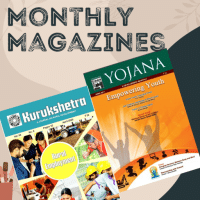Current Affairs Exam > Current Affairs Questions > Consider the following statements:1. Jharkhan...
Start Learning for Free
Consider the following statements:
1. Jharkhand has the highest number of severely acute malnourished children in 2020.
2. The National Family Health Survey-5 suggested the decrease in malnutrition among children in 2019-20 from 2015-16.
3. The Sustainable Development Goal (SDG-2) aims to end all forms of hunger and malnutrition by 2030.
Which of the statements given above is/are not correct?
- a)1 only
- b)1 and 2 only
- c)2 only
- d)1, 2 and 3
Correct answer is option 'B'. Can you explain this answer?
Verified Answer
Consider the following statements:1. Jharkhand has the highest number ...
- The World Health Organisation (WHO) defines ‘severe acute malnutrition’ (SAM) by very low weight-for-height or a mid-upper arm circumference less than 115 mm, or by the presence of nutritional oedema.
- An estimated 9,27,606 ‘severely acute malnourished’ children from six months to six years were identified across the country till November 2020.
- States with SAM Children:
- The most in Uttar Pradesh (3,98,359) followed by Bihar (2,79,427).
- Maharashtra (70,665) > Gujarat (45,749) > Chhattisgarh (37,249) > Odisha (15,595) > Tamil Nadu (12,489) > Jharkhand (12,059) > Andhra Pradesh (11,201) > Telangana (9,045) > Assam (7,218) > Karnataka (6,899) > Kerala (6,188) > Rajasthan (5,732).
- Hence, statement 1 is not correct.
- The Sustainable Development Goal (SDG 2: Zero hunger) aims to end all forms of hunger and malnutrition by 2030, making sure all people – especially children – have access to sufficient and nutritious food all year round. Hence, statement 3 is correct.
- National Family Health Survey-4 (NFHS-4), 2015-16 suggests that prevalence of severe acute malnutrition among children was at 7.4%.
- The National Family Health Survey (NFHS)-5 suggests that malnutrition increased among children in 2019-20 from 2015-16 in 22 states and UTs. Hence, statement 2 is not correct.
- Stunted: Around 13 states and UTs out of the 22 surveyed recorded a rise in percentage of children under five years who are stunted in comparison to 2015-16.
- Wasted: 12 states and UTs recorded a rise in the percentage of children under five years who are wasted.
- Severely wasted and underweight: 16 states and UTs recorded a rise in the percentage of children under five years who are severely wasted and underweight in 2019-20.
Most Upvoted Answer
Consider the following statements:1. Jharkhand has the highest number ...
- The World Health Organisation (WHO) defines ‘severe acute malnutrition’ (SAM) by very low weight-for-height or a mid-upper arm circumference less than 115 mm, or by the presence of nutritional oedema.
- An estimated 9,27,606 ‘severely acute malnourished’ children from six months to six years were identified across the country till November 2020.
- States with SAM Children:
- The most in Uttar Pradesh (3,98,359) followed by Bihar (2,79,427).
- Maharashtra (70,665) > Gujarat (45,749) > Chhattisgarh (37,249) > Odisha (15,595) > Tamil Nadu (12,489) > Jharkhand (12,059) > Andhra Pradesh (11,201) > Telangana (9,045) > Assam (7,218) > Karnataka (6,899) > Kerala (6,188) > Rajasthan (5,732).
- Hence, statement 1 is not correct.
- The Sustainable Development Goal (SDG 2: Zero hunger) aims to end all forms of hunger and malnutrition by 2030, making sure all people – especially children – have access to sufficient and nutritious food all year round. Hence, statement 3 is correct.
- National Family Health Survey-4 (NFHS-4), 2015-16 suggests that prevalence of severe acute malnutrition among children was at 7.4%.
- The National Family Health Survey (NFHS)-5 suggests that malnutrition increased among children in 2019-20 from 2015-16 in 22 states and UTs. Hence, statement 2 is not correct.
- Stunted: Around 13 states and UTs out of the 22 surveyed recorded a rise in percentage of children under five years who are stunted in comparison to 2015-16.
- Wasted: 12 states and UTs recorded a rise in the percentage of children under five years who are wasted.
- Severely wasted and underweight: 16 states and UTs recorded a rise in the percentage of children under five years who are severely wasted and underweight in 2019-20.
Free Test
FREE
| Start Free Test |
Community Answer
Consider the following statements:1. Jharkhand has the highest number ...
Analysis of the Statements
To determine which statements are not correct, let's assess each one based on current knowledge and data trends.
Statement 1: Jharkhand has the highest number of severely acute malnourished children in 2020.
- This statement is not correct. While Jharkhand has faced significant malnutrition challenges, states like Uttar Pradesh and Madhya Pradesh have reported higher numbers of severely acute malnourished children. Thus, Jharkhand does not hold the highest position.
Statement 2: The National Family Health Survey-5 suggested the decrease in malnutrition among children in 2019-20 from 2015-16.
- This statement is correct. The NFHS-5 indicated a decline in the prevalence of stunting, wasting, and underweight among children compared to previous years, showing positive trends in addressing malnutrition.
Statement 3: The Sustainable Development Goal (SDG-2) aims to end all forms of hunger and malnutrition by 2030.
- This statement is correct. SDG-2 indeed focuses on ending hunger, achieving food security, improving nutrition, and promoting sustainable agriculture by 2030.
Conclusion
- Based on the analysis, only Statement 1 is incorrect.
Therefore, the correct answer is option B (1 and 2 only), as Statement 2 is accurate, and Statement 1 is the one that is incorrect.
To determine which statements are not correct, let's assess each one based on current knowledge and data trends.
Statement 1: Jharkhand has the highest number of severely acute malnourished children in 2020.
- This statement is not correct. While Jharkhand has faced significant malnutrition challenges, states like Uttar Pradesh and Madhya Pradesh have reported higher numbers of severely acute malnourished children. Thus, Jharkhand does not hold the highest position.
Statement 2: The National Family Health Survey-5 suggested the decrease in malnutrition among children in 2019-20 from 2015-16.
- This statement is correct. The NFHS-5 indicated a decline in the prevalence of stunting, wasting, and underweight among children compared to previous years, showing positive trends in addressing malnutrition.
Statement 3: The Sustainable Development Goal (SDG-2) aims to end all forms of hunger and malnutrition by 2030.
- This statement is correct. SDG-2 indeed focuses on ending hunger, achieving food security, improving nutrition, and promoting sustainable agriculture by 2030.
Conclusion
- Based on the analysis, only Statement 1 is incorrect.
Therefore, the correct answer is option B (1 and 2 only), as Statement 2 is accurate, and Statement 1 is the one that is incorrect.

|
Explore Courses for Current Affairs exam
|

|
Similar Current Affairs Doubts
Consider the following statements:1. Jharkhand has the highest number of severely acute malnourished children in 2020.2. The National Family Health Survey-5 suggested the decrease in malnutrition among children in 2019-20 from 2015-16.3. The Sustainable Development Goal (SDG-2) aims to end all forms of hunger and malnutrition by 2030.Which of the statements given above is/are not correct?a)1 onlyb)1 and 2 onlyc)2 onlyd)1, 2 and 3Correct answer is option 'B'. Can you explain this answer?
Question Description
Consider the following statements:1. Jharkhand has the highest number of severely acute malnourished children in 2020.2. The National Family Health Survey-5 suggested the decrease in malnutrition among children in 2019-20 from 2015-16.3. The Sustainable Development Goal (SDG-2) aims to end all forms of hunger and malnutrition by 2030.Which of the statements given above is/are not correct?a)1 onlyb)1 and 2 onlyc)2 onlyd)1, 2 and 3Correct answer is option 'B'. Can you explain this answer? for Current Affairs 2025 is part of Current Affairs preparation. The Question and answers have been prepared according to the Current Affairs exam syllabus. Information about Consider the following statements:1. Jharkhand has the highest number of severely acute malnourished children in 2020.2. The National Family Health Survey-5 suggested the decrease in malnutrition among children in 2019-20 from 2015-16.3. The Sustainable Development Goal (SDG-2) aims to end all forms of hunger and malnutrition by 2030.Which of the statements given above is/are not correct?a)1 onlyb)1 and 2 onlyc)2 onlyd)1, 2 and 3Correct answer is option 'B'. Can you explain this answer? covers all topics & solutions for Current Affairs 2025 Exam. Find important definitions, questions, meanings, examples, exercises and tests below for Consider the following statements:1. Jharkhand has the highest number of severely acute malnourished children in 2020.2. The National Family Health Survey-5 suggested the decrease in malnutrition among children in 2019-20 from 2015-16.3. The Sustainable Development Goal (SDG-2) aims to end all forms of hunger and malnutrition by 2030.Which of the statements given above is/are not correct?a)1 onlyb)1 and 2 onlyc)2 onlyd)1, 2 and 3Correct answer is option 'B'. Can you explain this answer?.
Consider the following statements:1. Jharkhand has the highest number of severely acute malnourished children in 2020.2. The National Family Health Survey-5 suggested the decrease in malnutrition among children in 2019-20 from 2015-16.3. The Sustainable Development Goal (SDG-2) aims to end all forms of hunger and malnutrition by 2030.Which of the statements given above is/are not correct?a)1 onlyb)1 and 2 onlyc)2 onlyd)1, 2 and 3Correct answer is option 'B'. Can you explain this answer? for Current Affairs 2025 is part of Current Affairs preparation. The Question and answers have been prepared according to the Current Affairs exam syllabus. Information about Consider the following statements:1. Jharkhand has the highest number of severely acute malnourished children in 2020.2. The National Family Health Survey-5 suggested the decrease in malnutrition among children in 2019-20 from 2015-16.3. The Sustainable Development Goal (SDG-2) aims to end all forms of hunger and malnutrition by 2030.Which of the statements given above is/are not correct?a)1 onlyb)1 and 2 onlyc)2 onlyd)1, 2 and 3Correct answer is option 'B'. Can you explain this answer? covers all topics & solutions for Current Affairs 2025 Exam. Find important definitions, questions, meanings, examples, exercises and tests below for Consider the following statements:1. Jharkhand has the highest number of severely acute malnourished children in 2020.2. The National Family Health Survey-5 suggested the decrease in malnutrition among children in 2019-20 from 2015-16.3. The Sustainable Development Goal (SDG-2) aims to end all forms of hunger and malnutrition by 2030.Which of the statements given above is/are not correct?a)1 onlyb)1 and 2 onlyc)2 onlyd)1, 2 and 3Correct answer is option 'B'. Can you explain this answer?.
Solutions for Consider the following statements:1. Jharkhand has the highest number of severely acute malnourished children in 2020.2. The National Family Health Survey-5 suggested the decrease in malnutrition among children in 2019-20 from 2015-16.3. The Sustainable Development Goal (SDG-2) aims to end all forms of hunger and malnutrition by 2030.Which of the statements given above is/are not correct?a)1 onlyb)1 and 2 onlyc)2 onlyd)1, 2 and 3Correct answer is option 'B'. Can you explain this answer? in English & in Hindi are available as part of our courses for Current Affairs.
Download more important topics, notes, lectures and mock test series for Current Affairs Exam by signing up for free.
Here you can find the meaning of Consider the following statements:1. Jharkhand has the highest number of severely acute malnourished children in 2020.2. The National Family Health Survey-5 suggested the decrease in malnutrition among children in 2019-20 from 2015-16.3. The Sustainable Development Goal (SDG-2) aims to end all forms of hunger and malnutrition by 2030.Which of the statements given above is/are not correct?a)1 onlyb)1 and 2 onlyc)2 onlyd)1, 2 and 3Correct answer is option 'B'. Can you explain this answer? defined & explained in the simplest way possible. Besides giving the explanation of
Consider the following statements:1. Jharkhand has the highest number of severely acute malnourished children in 2020.2. The National Family Health Survey-5 suggested the decrease in malnutrition among children in 2019-20 from 2015-16.3. The Sustainable Development Goal (SDG-2) aims to end all forms of hunger and malnutrition by 2030.Which of the statements given above is/are not correct?a)1 onlyb)1 and 2 onlyc)2 onlyd)1, 2 and 3Correct answer is option 'B'. Can you explain this answer?, a detailed solution for Consider the following statements:1. Jharkhand has the highest number of severely acute malnourished children in 2020.2. The National Family Health Survey-5 suggested the decrease in malnutrition among children in 2019-20 from 2015-16.3. The Sustainable Development Goal (SDG-2) aims to end all forms of hunger and malnutrition by 2030.Which of the statements given above is/are not correct?a)1 onlyb)1 and 2 onlyc)2 onlyd)1, 2 and 3Correct answer is option 'B'. Can you explain this answer? has been provided alongside types of Consider the following statements:1. Jharkhand has the highest number of severely acute malnourished children in 2020.2. The National Family Health Survey-5 suggested the decrease in malnutrition among children in 2019-20 from 2015-16.3. The Sustainable Development Goal (SDG-2) aims to end all forms of hunger and malnutrition by 2030.Which of the statements given above is/are not correct?a)1 onlyb)1 and 2 onlyc)2 onlyd)1, 2 and 3Correct answer is option 'B'. Can you explain this answer? theory, EduRev gives you an
ample number of questions to practice Consider the following statements:1. Jharkhand has the highest number of severely acute malnourished children in 2020.2. The National Family Health Survey-5 suggested the decrease in malnutrition among children in 2019-20 from 2015-16.3. The Sustainable Development Goal (SDG-2) aims to end all forms of hunger and malnutrition by 2030.Which of the statements given above is/are not correct?a)1 onlyb)1 and 2 onlyc)2 onlyd)1, 2 and 3Correct answer is option 'B'. Can you explain this answer? tests, examples and also practice Current Affairs tests.

|
Explore Courses for Current Affairs exam
|

|
Signup for Free!
Signup to see your scores go up within 7 days! Learn & Practice with 1000+ FREE Notes, Videos & Tests.


























